Running in Moccasins Empowered This Navajo Marathoner
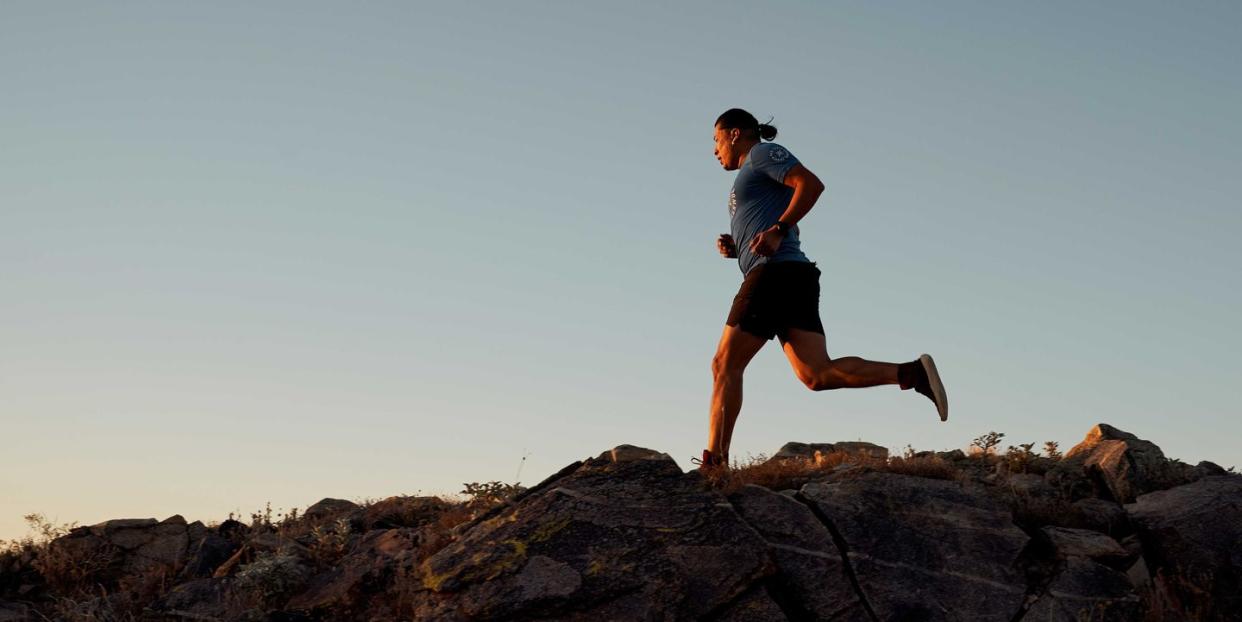
Harold Bennally runs over the red rocks like he’s keeping a drum beat. No matter if the northern Arizona trail climbs or descends or levels out, his cadence stays consistent. His moccasined feet hit the ground like mallets, his whole body in unison. This is his people’s sacred tradition of Ha’a’aahjigo dighádídeeshwoł, when many members of the Navajo tribe run east each morning to greet the day.
The Navajo believe running places them both on the earth and in the sky, that being out when the first light hits the earth empowers them to take on all challenges and live a stronger life. Running is a celebration, a prayer, a learning opportunity, and a mode of healing. Harold’s family made a ritual out of those early-morning runs, but for many years, Harold felt the journey to the sunrise was an obligation rather than a blessing. He strayed from the tradition, searching for something else to make him strong.
Harold, his parents, and his five siblings lived in Page, Arizona, a town of about 7,500 people just off the Navajo reservation, south of the Utah border. The U.S. Bureau of Reclamation obtained Page’s land through an exchange with the Navajo Nation in the late 1950s, when migrating construction workers were arriving in the region to build the Glen Canyon Dam on the Colorado River. Today, Indigenous people in Page walk a blurry line between what’s on and off the reservation. Navajo territory spans more than 27,000 square miles, stretching across much of northern Arizona, New Mexico, and Utah.

Growing up in Page placed Harold at the intersection of two worlds. His schools were one-third white, two-thirds Navajo. As the school bus crossed the boundary into reservation land each day, Harold would watch the infrastructure of Page’s population center fade into great expanses of striped rock, vivid plateaus, and quiet. “You know you’re on the reservation when the roads turn to gravel and double-track, and you can hear a truck approaching from miles away,” Harold says.
Growing up, Harold loved exploring the desert around Page. As children, he and his best friend Shaun Martin lived across a branch of Antelope Canyon from one another. They could see one another's homes from their front doors. As the boys grew up running and racing together, they explored the canyons dissecting their neighborhood—Antelope, Horseshoe Bend, Lake Powell—as if they were playgrounds, climbing the taffy-like rock formations that still attract tourists from around the world. Today, Harold still considers Shaun a brother.
But Harold's younger years also saw a good deal of time on the Navajo reservation. When he was 5 years old, he went to live with his grandfather, Harry Claw, for a year. Harry Claw was a medicine man, and Harold’s parents thought it would be valuable for their son to escape his sister-filled home and help out on Harry Claw's ranch. Harold could work, tend to the ranch animals, and learn the Navajo prayers, too. The hope was Harold would gain a new respect for his surroundings.

So when Harold was in kindergarten, his grandfather would wake him before dawn and have him run east, toward the sunrise. When little Harold reached the dead end of the double-track road—about a mile's distance from home—he’d turn around to run back in time to take care of his grandfather’s sheep, goats, and cattle. Those were Harold's first trail runs. “My grandfather told me, ‘This is what you do, because you’re Navajo,’” he says.
Harry Claw taught Harold the morning runs would mold him into a strong person, and prepare him to work hard and be disciplined.
To the Navajo, everything is a people. The rocks are rock people, the insects are insect people, the birds are bird people. The Navajo believe all of the people give energy, and running is a way to collect that energy and learn from everything you contact. “When you shake someone’s hand, you feel their energy. The Navajo believe that when you run, you feel the energy of everything around you — like shaking hands with the rocks, the animals, the sky,” Shaun Martin explains. “In Western culture, you hear a runner say they fed off of the crowd in a race. For the Navajo, it’s the same, we just have a bigger crowd. We’re fed by everything around us.” Running for the Navajo connects the physical and mental elements of the sport with something spiritual.
When Harold's grandfather, Harry Claw, was a younger medicine man, he would run great distances to relay messages and take care of his neighbors who couldn’t care for themselves. He ran in simple moccasins, as was the cultural way of life for his people. “The moccasin divides the earth from the sky,” Harold says. “Navajo live in that balance, so moccasins represent our connection point to everything else.”
But when Harold was a teenager, running wasn’t always the sacred act his grandfather described. Each morning, he and his older sisters would run toward first light through their Page neighborhood and on to the Navajo reservation. They went at the urging of their father. The siblings measured their distance in powerline poles—six poles out and six poles back was a good run.
And at Page High School, Harold mostly ran to race, win, and fit in with his friends. He signed up for the cross country team after his older sisters, and he says almost all the runners were Navajo. Beyond the tribe's established culture of running, Page was home to a pair of Navajo running heroes. They were Shaun Martin’s older twin brothers, Tim and Theo, in the house right across from Harold.
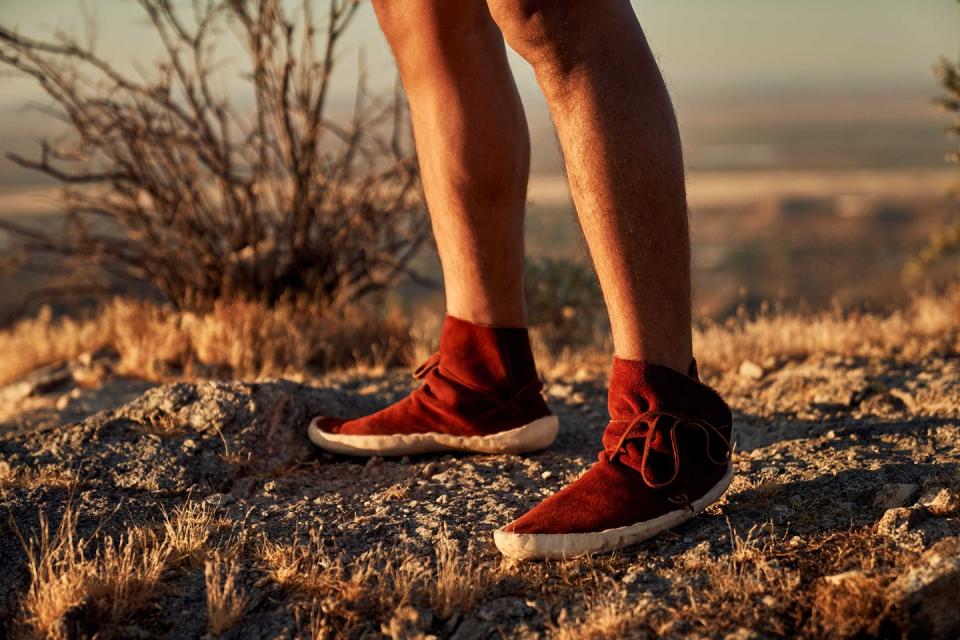
“Growing up, my dad would always tell my sisters and me, ‘one day you’ll be just like the Martins.’ Everyone wanted to be like them,” Harold says. Tim and Theo were up before first light every day, running east. They were both state champions in high school, and Theo went on to be a Division I All-American and world-record holder—he’s the fastest Native American marathoner in history, with a PR of 2:15:07.
Under the shadow of their respective older siblings, Harold and Shaun became hooked on racing, but for Harold, cross-country training was only about speed. He just wanted that feeling of hitting a PR. “The last thing on my mind was my grandfather, and what he taught me about the importance of running for our people. I just wanted to be the fastest.” Harold ran throughout high school, earned a scholarship to Pima Community College, and became a Junior College Cross Country All American. Shaun, meanwhile, earned a Division I scholarship to Northern Arizona University, where he ran for five years and set multiple school records. “We stayed in touch as best we could, but this was pre-social-media, so we talked less frequently,” Shaun says.
Shaun continued running after college, eventually becoming a competitive ultra-marathoner, but Harold quit after his Pima career. When the accolades stopped, so did he. “When I was out in the world, working, I didn’t see the benefit of running,” he says. “It wasn’t going to put food on my table, so it just didn’t matter.” Harold took a job at the Navajo Generating Station, a coal-fired power plant on the Navajo reservation. He worked long hours with heavy equipment, and in his spare time, he started weightlifting. His lean runner’s build filled out. He says he went from 160 pounds to 225. His Navajo identity was intact, he says, but his mind was a long way from those sunrise runs on the reservation.
Three years later, in 2012, Shaun pulled Harold back into the world of running. Shaun was in eastern Arizona coaching college cross country, and he had an idea: a Navajo owned and operated race, benefitting the Navajo people. "I told Harold to remember what running is—a celebration of life, a form of prayer, a teacher, and a medicine," Shaun says. "I asked him to run with me.” And Shaun says Harold, “like any brother would, said ‘definitely.’”
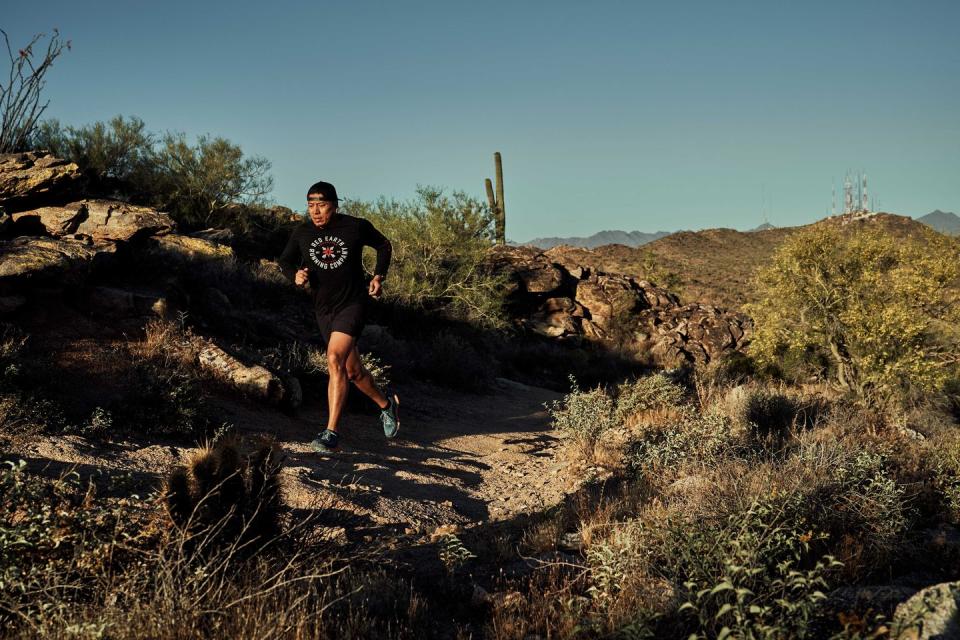
Harold and Shaun launched the Canyon de Chelly Ultra 55K in 2013. For Harold, the event was coming at a significant moment. He had started running in earnest again, but per Shaun's emphasis on tradition above competition, he had started to orient his running toward Navajo identity and culture again. He prepared for the ultra with the 2013 Shiprock Marathon—the only road marathon on the Navajo Nation—and he poured hours of hard labor into Canyon de Chelly itself, hauling water to checkpoints around the course and cooking the traditional Navajo meals that would bookend the race—blue corn mash at the start, goat stew with frybread at the finish.
Amid these preparations for Canyon de Chelly, Harold's father fell sick with respiratory lung disease. Harry James had always represented the link for his son between Navajo culture and the rest of the world. He had been Harold’s primary resource for Navajo history, and teachings—the man who could explain anything. In 2014, Harry James' illness became acute, and Harold's reconnection with the Navajo took on a greater urgency. His training increased. After missing the inaugural Canyon de Chelly Ultra due to bronchitis, he BQ'd at the 2014 Shiprock Marathon, placing fourth overall with a time of 3:00:26. He signed up for the second running of the Canyon de Chelly later that year. He was on a cultural mission.
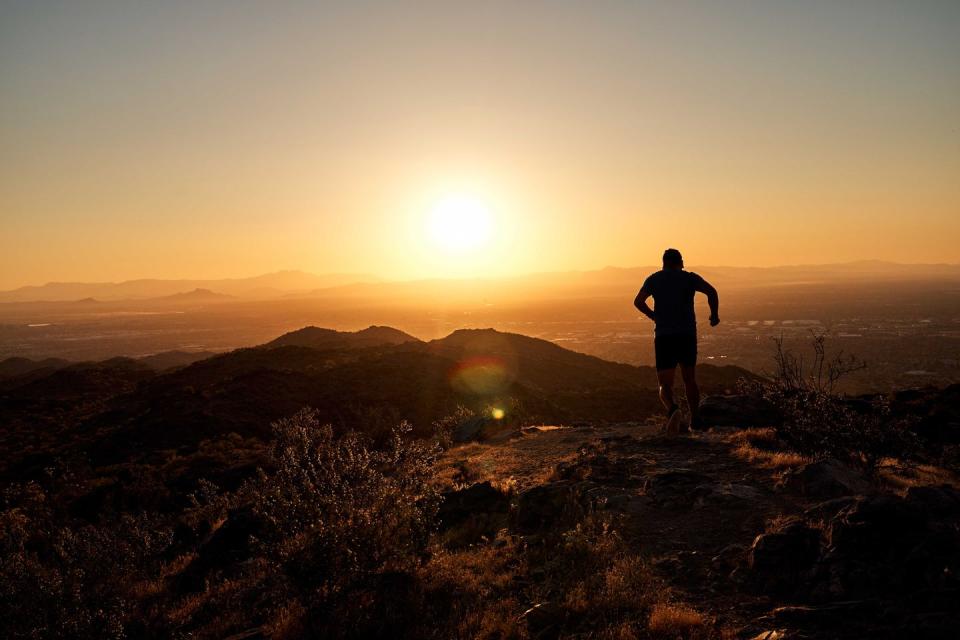
Harry James illness took a turn for the worse, so Harold began spending more time at home, sharing his running journey with his father and telling him all about the Shiprock runs and the Canyon de Chelly. “My father was proud that I was using running as a prayer," he says. "He knew that it was making me stronger in every way.”
When Harold finally ran the 2014 Canyon de Chelly, he placed 13th, but he found the event deemphasized pace and time. Canyon de Chelly is limited to 150 runners because its route goes through a living national monument, and runners are encouraged not to wear watches so they pay attention to the landscape. “You can’t talk about this race—the scenery or the trails—without talking about a spiritual experience,” Shaun says. “If you want to know what it’s like to run here, you have to come and do it. It changes people’s lives.”
Harry James passed away in 2015, two weeks before Harold’s Boston Marathon. For Harold, the loss was intense. “I sat down and just breathed. I thought about not going [to the race]. But then I thought about morning runs with my family—out before sunrise. I thought about how many times my father traveled to watch me run in high school and cheer me on. I thought about how I had qualified for the biggest race in the country. And I knew I had to go to Boston because of my father—because of my family.”
Harold made a last-second decision in Boston to change his race gear. He swapped his running shirt for a simple cotton tank top from Walmart. On the back, he wrote his father’s name, the year Harry James was born, and the year Harry James died. On the front, he wrote ‘For Dad.’ For him, the race had a new, restorative energy. “From the start to the end, people were screaming, ‘Dad! Dad! Dad!’ and ‘Do it for Dad. He’s watching,’” he says. “It was like electricity.”
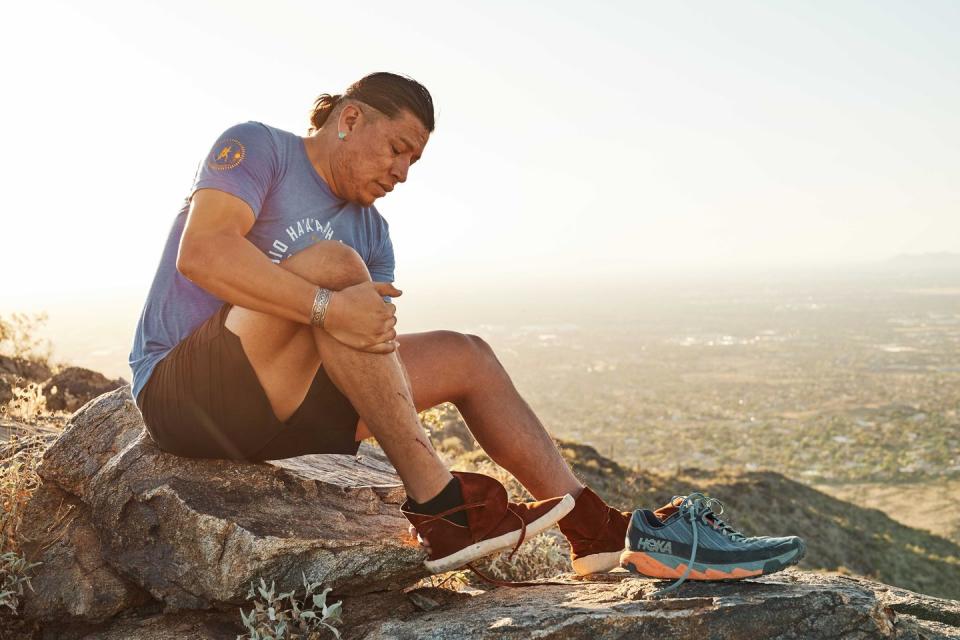
Harold flew home from Boston on a high. Two weeks later, he ran Shiprock again in front of his family—and he won. He says the performance inspired him to define a new ‘why’ for his relationship to the sport. He wanted his running to be rooted in family and tradition. He wanted his young nieces and nephews to look up to him the way he looked up to the Martins. He wanted to be connected to his family even if he wasn’t breaking the tape. “My grandfather ran day in and day out across the reservation to other families, carrying messages and food and water just to help them survive. I wanted to run to keep that spirit alive.”
In the tradition of his people, Harold decided to start running in moccasins — cowhide leather, white on the bottom and red on top, with laces above the ankles. They’re similar to the ones his grandfather and father wore in sacred ceremonies, to the ones his ancestors wore for generations before him. Almost nothing between his feet and the ground.

Running in moccasins was like learning to run all over again, Harold says. He only wore them for a mile or a two at a time at first, but he says over time, he felt muscles developing in his feet, legs, hips, and back that he had never felt with other footwear. “There’s so much cushioning in mainstream running shoes — so many muscles don’t develop. But in the moccasins, all the muscle fibers get realigned.” It was like awakening a superpower. Harold stopped thinking so much about speed, and started orienting toward his ancestors, the earth, the sky, his people. He made a goal to run the Boston Marathon in moccasins. He started talking about it, a lot, and word began to spread.
In the spring of 2018, Harold received an Instagram message from Dirk Whitebreast (Meskwaki tribe) and his wife, Lannesse Baker (Turtle Mountain/Chippewa tribe). Whitebreast and Baker are the founders of the Red Earth Running Company in Tama, Iowa, an independent running brand that promotes indigenous running. They wanted Harold to be an ambassador. After meeting with Whitebreast in Zion National Park, known to the native Southern Paiute as Mukuntuweap—meaning "straight canyon"—Harold agreed, and Red Earth now supports his race entries. For his part, Harold serves as a spokesman at Red Earth Running Company events and within their online community. In 2019, he welcomed a t-shirt design from Whitebreast and Baker for his running of the Boston Marathon in moccasins. The shirt says, “Ha’a’aahjigo dighádídeeshwoł"—"I will run to the east to greet the day."
But Harold wanted to give back to the Navajo running community directly. This time, he asked Shaun to help him launch a race — and in 2018, they birthed the Canyon X Half Marathon in LeChee Rock, Arizona. Canyon X entry fees go toward off-season training for Navajo high-school runners, as well as community-building trips for Navajo youth to places like the Grand Canyon, where the kids learn about the relationship between running and the Navajo culture.
Harold still races in moccasins to bring awareness to his culture and his people, but he also does it for himself. “After my father passed, I looked at running in a different way. My culture is so much bigger than trophies or winning. Running is my medicine — it’s what keeps me alive.” The shoes make Harold stronger, and they make him feel strong. He now realizes those are two different things.
You Might Also Like

